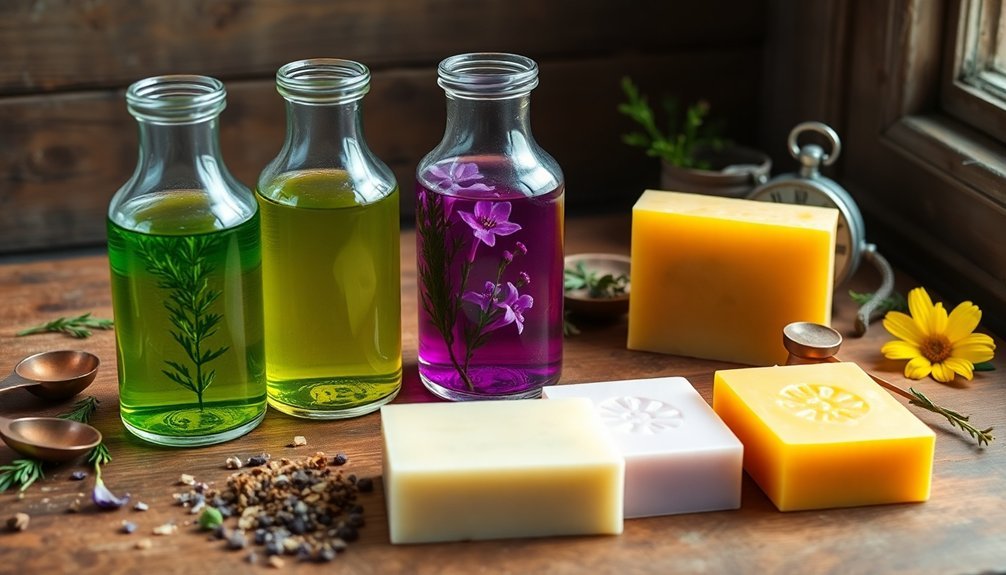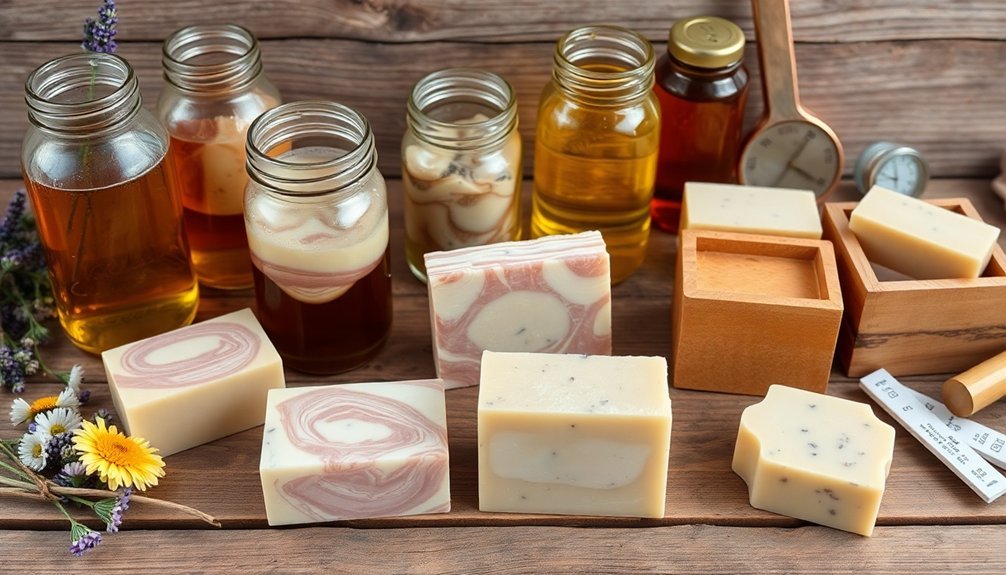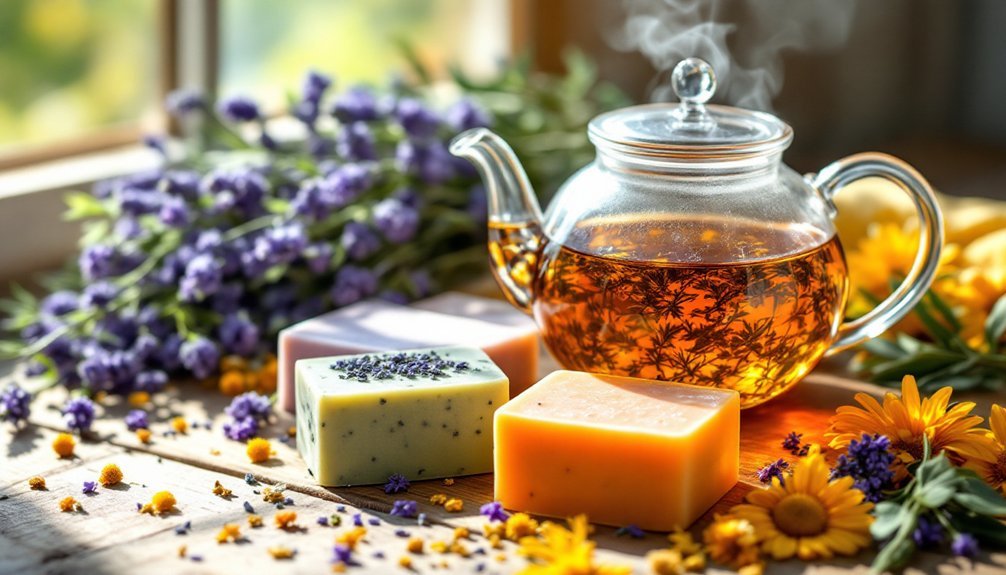Create exceptional handmade soap by selecting herbs like chamomile and calendula for specific therapeutic benefits. Master oil infusion by using dried herbs fully submerged in carrier oils, either through solar or stovetop methods. Add delicate herbs at trace for potency, while incorporating hardier botanicals during mixing. Combine complementary herbs like peppermint with lavender for balanced effects. Maintain herbal integrity by respecting temperature sensitivities during saponification. These five secrets transform ordinary soap into personalized healing creations.
Selecting the Right Herbs for Your Soap's Therapeutic Benefits

Why settle for ordinary soap when nature offers a treasure trove of herbs with remarkable skin benefits? Choosing the right herbs can transform your handmade soap from basic to therapeutic.
Consider chamomile for its soothing and anti-inflammatory properties, perfect for sensitive skin.
Lavender works wonders for skin irritation while providing a calming aroma.
For wound-healing and antibacterial properties, calendula is your ally, effectively treating cuts and irritations.
Need something invigorating? Peppermint delivers exfoliating benefits and a revitalizing cooling sensation for tired skin.
Don't overlook nettle, which enriches your soap with essential vitamins and minerals that nourish both skin and hair.
Each herb brings unique therapeutic benefits to your soap, allowing you to create custom formulations targeted to specific skin concerns.
Mastering Oil Infusion Techniques for Maximum Potency
How effectively you infuse herbs into your base oils directly determines the therapeutic power of your handmade soap. To create potent herbal oils, place dried herbs in a clean jar and completely cover with carrier oils. Ground herbs extract more beneficial properties than whole ones, but use them sparingly to prevent over-saturation.
You can choose between two methods: cold infusion (solar method), where you'll place your jar in sunlight for several weeks, or stovetop infusion using a double-boiler kept below 140°F.
Whichever technique you select, make sure herbs remain fully submerged to prevent mold growth and preserve their moisturizing qualities.
Before incorporating your infused oil into homemade soap, always strain the herbs thoroughly. This removes particles that might affect your natural ingredients' texture, resulting in a smooth, professional-looking product with enhanced therapeutic benefits.
Timing Your Herbal Additions for Optimal Color and Properties

When you add herbal infusions to your soap determines their ultimate effectiveness and visual appeal. For maximum benefits, incorporate infusions at trace to guarantee even distribution throughout your soap batter. If you're working with dried herbs, add them during the mixing phase to fully release their color and therapeutic properties.
| Herbal Addition | Timing | Result |
|---|---|---|
| Delicate herbs (chamomile, calendula) | Pre-infuse in carrier oil, add at trace | Preserved color and potency |
| Color-sensitive herbs | Just before pouring into molds | Minimized color changes from saponification |
| Antioxidant-rich herbs | Final mixing stage | Maximum skin benefits |
To prevent unwanted darkening during saponification, add color-sensitive herbs later in the process. Remember that proper timing not only enhances visual appeal but also maximizes the therapeutic qualities your herbal infusions bring to your handcrafted soap.
Balancing Botanical Combinations for Complementary Effects
The art of combining botanicals in soap making lies in understanding how different herbs work together to enhance their collective benefits.
When creating herbs and oils infusions, pair chamomile with calendula for a soothing blend that addresses sensitive skin through their complementary anti-inflammatory properties.
For a balanced sensory experience, combine peppermint with lavender essential oils—the former invigorates while the latter calms.
Consider different skin types when blending nettle and rosemary, which together provide superior nourishment and antioxidant protection.
Those with problematic skin conditions will benefit from lemon balm and yarrow combinations that simultaneously calm the nervous system and combat inflammation.
For antibacterial power, mix goldenseal with calendula, which not only enhances your soap's therapeutic effects but also creates appealing natural colors.
Preserving Herbal Properties Throughout the Saponification Process

Preserving the delicate therapeutic properties of herbs throughout the saponification process requires careful attention to timing and technique.
Start by creating infused oils using the gentle solar infusion method, allowing herbs to steep for up to 6 weeks to maximize potency.
When crafting your soap recipe, adopt the cold process method, which doesn't apply external heat, helping maintain integrity of herbal properties.
Balance your infused oils with carrier oils to guarantee both therapeutic benefits and proper soap texture.
Add essential oils at trace rather than at the beginning of saponification. This strategic timing prevents the chemical reaction's heat from degrading their therapeutic qualities.
Your herbal infusion will retain its beneficial compounds when you respect these temperature sensitivities throughout the soap-making journey.
Frequently Asked Questions
What Herbs Are Good for Homemade Soap?
You'll find yarrow, chamomile, peppermint, calendula, and lavender excellent for homemade soap. They offer benefits ranging from antibacterial properties to skin-soothing qualities while adding natural color and appealing fragrance to your creations.
How to Infuse Oil With Herbs for Soap Making?
To infuse oil with herbs for soap making, place dried botanicals in a jar, cover with carrier oil, and steep for 4 hours to 6 weeks. You'll need to strain the mixture through cheesecloth when finished.
What Is the Best Hardener for Soap Making?
For the best soap hardeners, you'll want to use coconut oil for bubbles, palm oil for stability, and shea butter for moisture. Balance these hard oils with soft oils to create soap that's both firm and nourishing.
What Ingredient Makes Soap Effective?
Sodium hydroxide (lye) makes your soap effective by triggering saponification, where it reacts with oils and fats. You'll create true soap through this chemical process, which produces both soap molecules and glycerin.
In Summary
You're now equipped to transform your soap-making with the power of herbs! Remember to select herbs aligned with your goals, master infusion methods, time additions strategically, balance complementary botanicals, and protect those precious properties during saponification. With these five herbal secrets, you'll create soaps that aren't just cleansers, but therapeutic experiences your skin will thank you for!





Leave a Reply